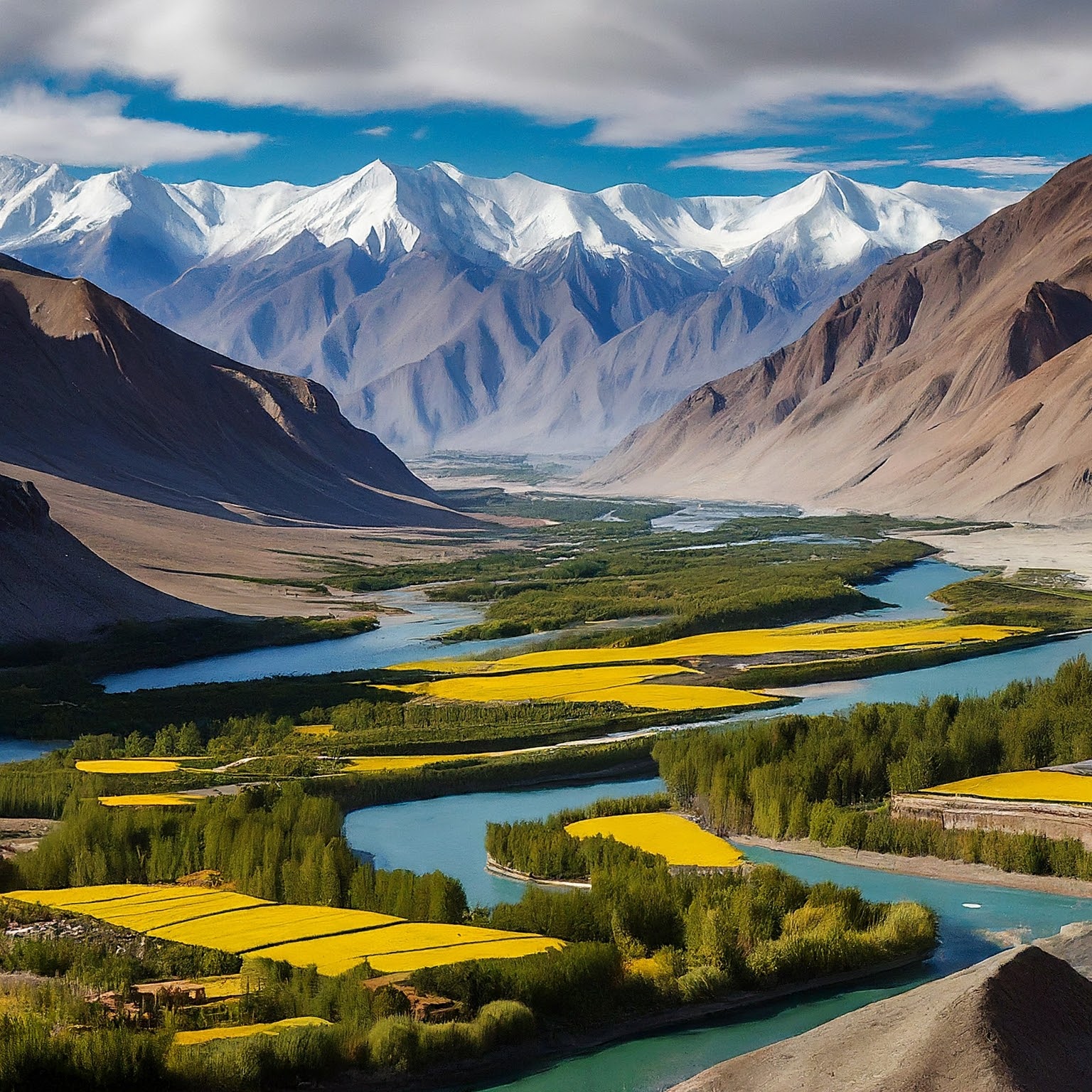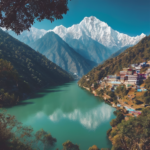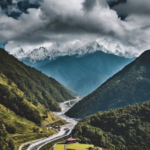“Embark on an adventure to Ladakh, a high-altitude desert region in northern India, where rugged landscapes, ancient monasteries, and vibrant Tibetan culture come together to offer a unique and captivating journey into the Himalayas”.
Ladakh’s pristine landscapes boast rugged mountain peaks piercing cerulean skies, while tranquil lakes shimmer against a backdrop of barren yet captivating terrain, forming a harmonious symphony of nature’s raw beauty.

Main Attraction
Ladakh, often referred to as the “Land of High Passes,” is a region of breathtaking beauty nestled in the northern part of India’s Jammu and Kashmir state. It’s renowned for its stark landscapes, pristine lakes, ancient monasteries, and vibrant culture. Here are some of Ladakh’s main attractions:
Pangong Lake: This stunning high-altitude lake is famous for its crystal-clear blue waters and picturesque surroundings. It gained international fame after being featured in the Bollywood movie “3 Idiots.”
Nubra Valley: Known for its surreal landscapes, including sand dunes, lush green villages, and the famous double-humped Bactrian camels, Nubra Valley offers a unique experience for travelers.
Leh Palace: This historic palace, located in Leh, the capital of Ladakh, offers panoramic views of the town and the surrounding mountains. It’s a fascinating example of medieval Tibetan architecture.
Thiksey Monastery: Perched atop a hill, Thiksey Monastery is one of the largest and most impressive monasteries in Ladakh. It houses numerous sacred artifacts, murals, and a statue of Maitreya (the future Buddha).
Hemis Monastery: Known for its annual Hemis Festival, this monastery is one of the wealthiest and most significant in Ladakh. It’s home to a massive thangka (Tibetan Buddhist painting) that is displayed once every 12 years during the festival.
Shanti Stupa: Built to promote world peace, Shanti Stupa offers panoramic views of Leh and the surrounding mountains. It’s a serene place to witness stunning sunrises and sunsets.
Khardung La Pass: Claimed to be one of the highest motorable passes in the world, Khardung La offers breathtaking views of the snow-capped peaks of the Ladakh range.
Alchi Monastery: Renowned for its exquisite frescoes and ancient sculptures, Alchi Monastery is one of the oldest monastic complexes in Ladakh, dating back to the 11th century.
Zanskar Valley: A remote and rugged valley known for its stunning landscapes, deep gorges, and isolated villages. It’s a trekker’s paradise during the summer months.
Chang La Pass: Another high-altitude pass, Chang La, offers spectacular views of the surrounding mountains. It’s en route to Pangong Lake and is often covered in snow even during the summer.
These are just a few of the many attractions that Ladakh has to offer. Its unique blend of natural beauty, rich cultural heritage, and spiritual significance makes it a truly unforgettable destination for travelers.
Foods to Taste.
Ladakhi cuisine reflects the region’s unique geography and cultural heritage, with influences from Tibetan, Indian, and Central Asian culinary traditions. Here are some traditional Ladakhi foods you should try during your visit:
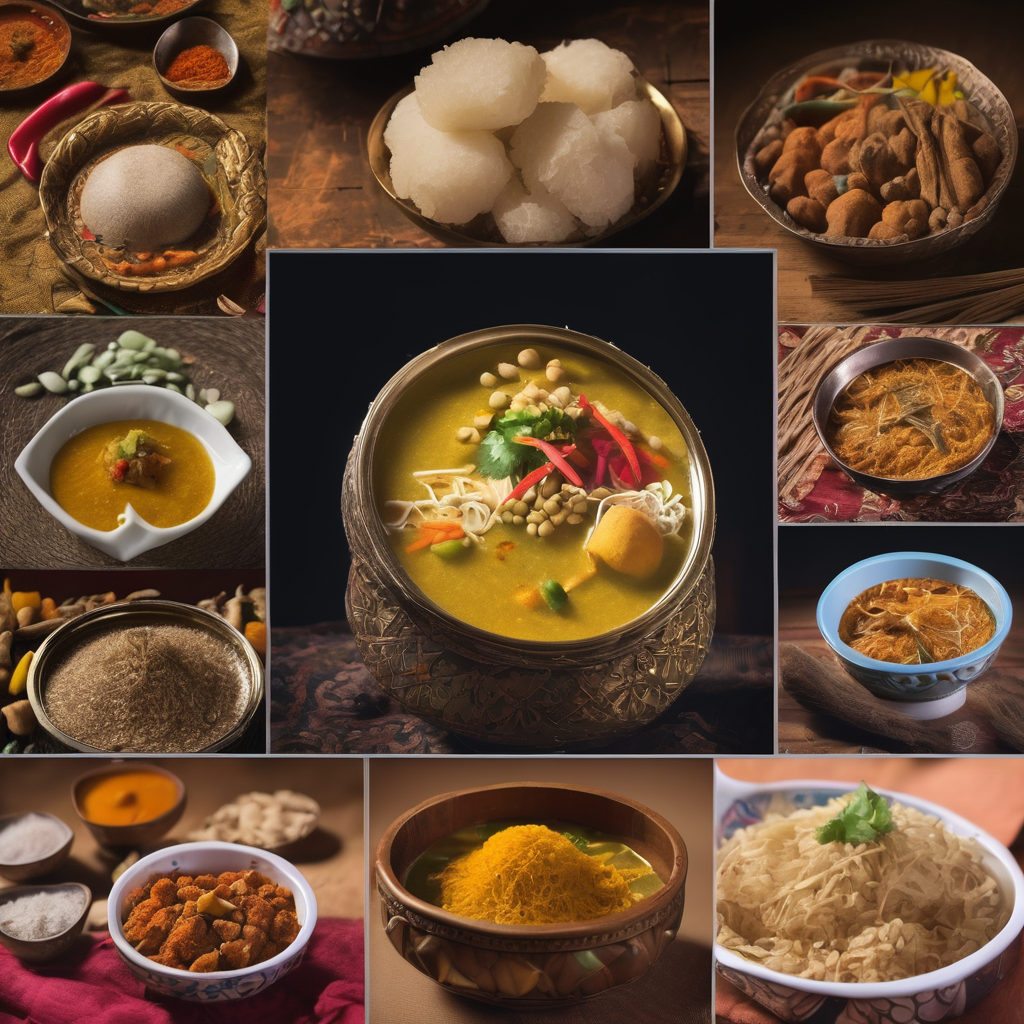
Thukpa: A hearty noodle soup made with vegetables, meat (usually mutton), and aromatic spices. Thukpa is a popular comfort food in Ladakh and is often enjoyed during the colder months.
Momos: These steamed or fried dumplings are a staple in Ladakh and come with various fillings such as vegetables, meat, or cheese. They are typically served with spicy chili sauce or a tangy tomato-based dip.
Skyu: A hearty stew made with wheat flour noodles, vegetables, and sometimes meat. Sku is a traditional Ladakhi dish that is enjoyed as a main course and is known for its comforting and filling nature.
Chang: A traditional alcoholic beverage made from fermented barley or millet. Chang is served in wooden containers called “changkoks” and is an integral part of Ladakhi social gatherings and festivals.
Butter Tea (Tsamik): A savory tea made with black tea leaves, yak butter, salt, and sometimes milk. Butter tea is a staple beverage in Ladakh and is valued for its warming and energizing properties, especially in the cold mountainous climate.
Apricot Jam: Ladakh is known for its juicy apricots, and apricot jam is a popular delicacy made from locally grown apricots. It’s often enjoyed with bread or as a topping for desserts.
Chhurpi: A type of dried cheese made from yak or cow milk. Chhurpi has a chewy texture and is commonly eaten as a snack or used as an ingredient in traditional Ladakhi dishes.
Gurgur Cha: A refreshing drink made from green tea leaves, butter, and salt. Gurgur cha is served cold and is believed to have cooling properties, making it a popular beverage during the summer months.
Phingsha: A traditional Ladakhi dish made with minced meat (usually yak meat), mixed with barley flour, and shaped into small balls. Phingsha is then boiled in a savory broth and served as a hearty soup.
Tingmo: Steamed Tibetan bread rolls that are soft and fluffy. Tingmo is often served alongside savory dishes or used to soak up flavorful gravies and sauces.
These are just a few examples of the delicious and unique foods you can enjoy while exploring Ladakh. Be sure to seek out local eateries and try authentic Ladakhi cuisine for a truly memorable culinary experience.
Best time to visit.
Ladakh experiences extreme weather conditions, with winter temperatures dropping well below freezing and summer temperatures being pleasant during the day but cold at night. The best time to visit Ladakh is during the summer months, from May to September. During this period, the weather is relatively mild, and most of the region’s attractions are accessible due to the melting of snow, making it ideal for outdoor activities such as trekking, sightseeing, and exploring the stunning landscapes. Additionally, clear skies during this time offer excellent visibility for enjoying Ladakh’s breathtaking views and taking part in various cultural festivals.
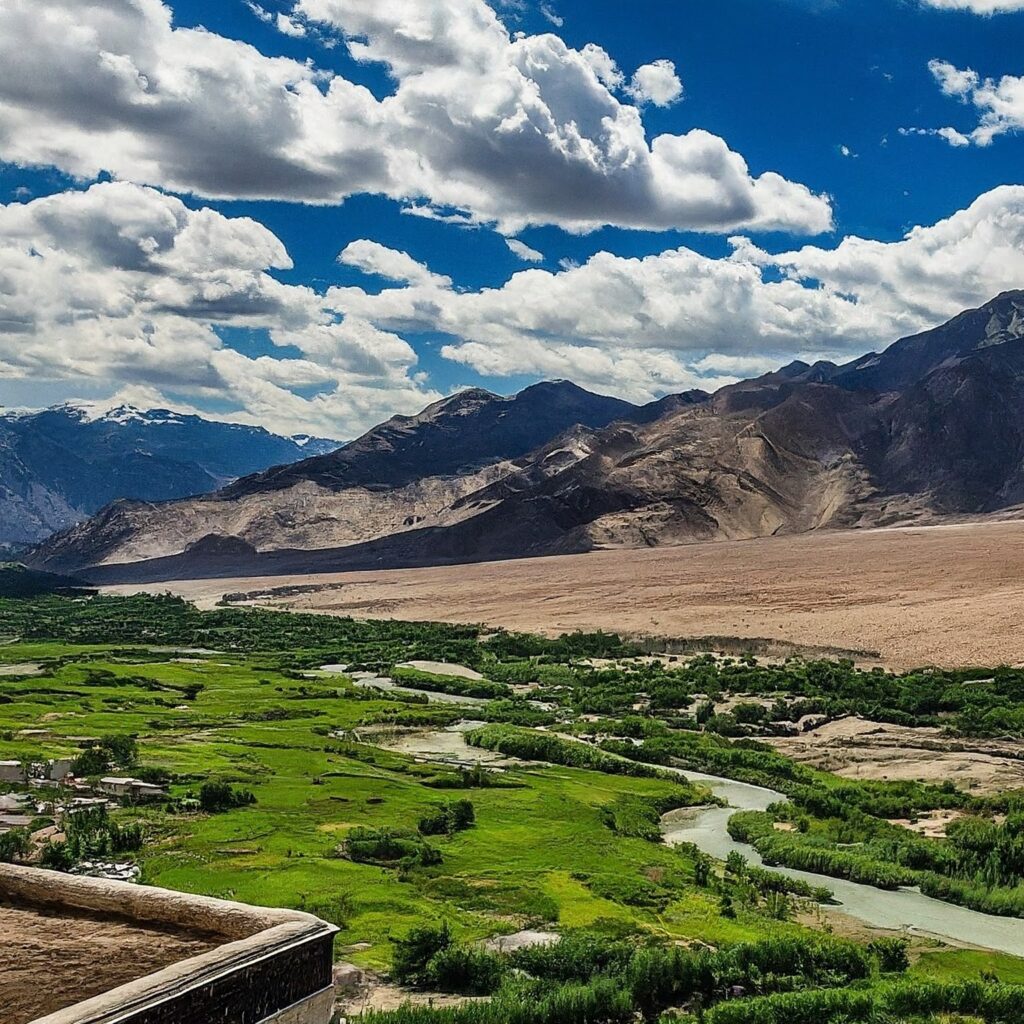
Special Notes:
Permits: Travelers to Ladakh, especially foreigners, require certain permits to visit restricted areas like Nubra Valley, Pangong Lake, and Tso Moriri. Make sure to obtain these permits in advance through a registered travel agency or the Leh District Magistrate’s office.
Altitude Acclimatization: Ladakh’s high altitude can cause altitude sickness or acute mountain sickness (AMS) in some people. It’s essential to acclimatize properly by spending a couple of days in Leh and gradually ascending to higher altitudes to allow your body to adjust to the decreased oxygen levels.
Transportation: Ladakh’s rugged terrain requires careful planning for transportation. Options include renting a private vehicle, hiring a taxi, or joining a guided tour. Public transportation is limited, so it’s advisable to arrange transportation in advance.
How to go ?
Getting to Ladakh typically involves traveling by air or road, depending on your starting point. Here’s how you can reach Ladakh:
By Air:
The easiest and quickest way to reach Ladakh is by air. The Kushok Bakula Rimpochee Airport in Leh is the main airport serving the region. It has regular flights from major cities in India, including Delhi, Mumbai, Srinagar, and Chandigarh. Several airlines operate flights to Leh, and the flight duration from Delhi is approximately 1.5 to 2 hours.
By Road:
From Srinagar: If you prefer a scenic road trip, you can travel to Ladakh from Srinagar, the summer capital of Jammu and Kashmir. The Srinagar-Leh Highway (NH1) offers breathtaking views of the Himalayas and passes through picturesque landscapes, including Sonamarg, Drass, and Kargil. The road is open from around May to November, depending on weather conditions.
From Manali: Another popular route is the Manali-Leh Highway (NH3), which connects Ladakh to Manali in Himachal Pradesh. This route is known for its challenging terrain, high mountain passes, and stunning vistas. The road is typically open from late May or early June to September or October, depending on weather conditions.
By Bus:
State-run and private buses operate between Leh and nearby towns like Srinagar and Manali during the summer months when the roads are open. However, the journey can be long and tiring due to the rough terrain and high altitude.
By Motorcycle:
Many adventure enthusiasts opt to travel to Ladakh by motorcycle, either on their own bikes or by renting one locally. The scenic routes and challenging terrain make it a popular choice for motorcycle tours. However, it’s essential to have prior experience riding in mountainous regions and to be prepared for the altitude and weather conditions.
Before traveling to Ladakh, especially by road, it’s essential to check the current road conditions, obtain any necessary permits, and acclimatize to the high altitude to ensure a safe and enjoyable journey.
Travel Tips:
Here are some travel tips to help you make the most of your trip to Ladakh:
Acclimatize Properly: Ladakh’s high altitude can cause altitude sickness (AMS). Spend at least a couple of days in Leh to acclimatize before heading to higher altitudes. Avoid strenuous activity during the first few days and drink plenty of water to stay hydrated.
Pack Accordingly: Ladakh experiences drastic temperature changes throughout the day, so pack layers of clothing, including warm jackets, thermals, hats, and gloves. Sunscreen, sunglasses, and lip balm with SPF are essential to protect against the strong sun and dry air.
Stay Hydrated: The high altitude and dry climate can lead to dehydration. Drink plenty of water, herbal teas, and soups to stay hydrated. Avoid alcohol and caffeinated beverages, as they can exacerbate dehydration.
Protect Against Sun Exposure: The sun’s UV rays are stronger at high altitudes, so apply sunscreen with a high SPF rating regularly, especially on exposed skin. Wear a wide-brimmed hat, sunglasses with UV protection, and lightweight, long-sleeved clothing to shield yourself from the sun.
Respect Local Customs: Ladakh has a rich cultural heritage, so be respectful of local customs and traditions. Dress modestly, especially when visiting monasteries and religious sites. Remove your shoes before entering temples and monasteries and ask for permission before taking photographs of people.
Be Prepared for Limited Connectivity: Internet and mobile phone connectivity can be limited in remote areas of Ladakh. Inform your family and friends about your travel plans and check in with them whenever you have access to communication.
Carry Cash: While some establishments in Leh accept credit and debit cards, it’s advisable to carry enough cash for your expenses, especially in remote areas where card payment may not be available.
Responsible Travel: Help preserve Ladakh’s pristine environment by minimizing your impact on nature. Dispose of waste properly, avoid using single-use plastics, and support eco-friendly accommodations and businesses.
Travel Insurance: Consider purchasing travel insurance that covers medical emergencies and evacuation, especially when traveling to remote areas with limited medical facilities.
Be Flexible: Weather conditions in Ladakh can be unpredictable, so be prepared for changes in your itinerary. Stay flexible and open-minded and embrace the adventure of exploring this rugged and remote region.
By following these travel tips, you can have a safe, enjoyable, and enriching experience exploring the natural beauty and cultural heritage of Ladakh.
Travel Cost.
The cost of traveling to Ladakh can vary depending on factors such as the mode of transportation, accommodation type, activities, and personal preferences. Here’s a breakdown of potential expenses to consider:
Transportation:
Flights: The cost of flights to Leh, the main city in Ladakh, can vary depending on factors such as the time of booking, airline, and departure city. Flights from major Indian cities like Delhi, Mumbai, and Srinagar typically range from approximately $80 to $200 for a one-way ticket, but prices can fluctuate.
Road Travel: If you choose to travel by road, expenses will include fuel costs, vehicle rental (if applicable), and permits. If you’re hiring a taxi or joining a tour, expect to pay for transportation services based on distance and itinerary.
Accommodation:
Hotels: Accommodation options in Ladakh range from budget guesthouses and homestays to luxury hotels and resorts. Prices can vary widely depending on the location, season, and amenities. Budget accommodations may cost anywhere from $15 to $40 per night, while mid-range to luxury options can range from approximately $40 to $130 or more per night.
Camping: Camping is a popular option for adventurous travelers in Ladakh. Campsites and tented accommodations vary in price, with basic campsites costing around $7 to $20 per night and luxury tented camps costing more.
Food and Dining:
Local Cuisine: Eating at local restaurants and street stalls is an affordable option in Ladakh. A typical meal at a local eatery may cost around $3 to $7 per person, depending on the dishes and location.
Western Cuisine: Some restaurants in Leh cater to Western tastes and offer a variety of cuisines, including Indian, Tibetan, and international dishes. Prices at these establishments may be slightly higher.
Permits and Entrance Fees:
Some areas in Ladakh require permits for tourists, especially restricted areas like Nubra Valley, Pangong Lake, and Tso Moriri. Permit costs vary depending on the area and nationality. Entrance fees may also apply to visit certain attractions and monasteries.
Activities and Excursions:
Costs for activities such as trekking, rafting, sightseeing tours, and cultural experiences can vary. Guided tours and packages may include transportation, accommodation, and activity costs, providing a convenient way to explore Ladakh’s attractions.
Miscellaneous Expenses:
Additional expenses may include souvenirs, snacks, bottled water, and other incidentals.
Overall, a rough estimate for a budget traveler may be approximately $130 to $200 per day, including accommodation, meals, transportation, and activities. However, costs can vary widely depending on individual preferences and travel style. It’s advisable to plan and budget accordingly based on your specific needs and priorities.
Sample daily budget.
A traveller visiting Ladakh on a moderate budget:
Accommodation:
Budget Option: approximately $20 per night
Mid-range Option: approximately $45 per night
Food and Dining:
Breakfast at a local eatery: approximately $3
Lunch at a restaurant: approximately $4
Dinner at a mid-range restaurant: approximately $7
Snacks and drinks: approximately $3
Transportation:
Daily transportation (taxi/tuktuk/bus): approximately $7
Permits and Entrance Fees:
Permit for restricted areas (if applicable): approximately $8.
Entrance fees for attractions: approximately $3
Activities:
Half-day sightseeing tour: approximately $13
Trekking excursion: approximately $26
Miscellaneous:
Souvenirs and incidentals: approximately $7
Adding these up, a sample daily budget for a moderate traveller could look like this:
Budget Option: accommodation + food + transportation + permits and entrance fees + activities + miscellaneous = approximately $100
Mid-range Option: accommodation + food + transportation + permits and entrance fees + activities + miscellaneous = approximately $130
Keep in mind that these are rough estimates, and actual expenses may vary depending on factors such as individual preferences, travel style, and unforeseen circumstances. It’s always a good idea to have some extra funds available for emergencies or unexpected expenses.


